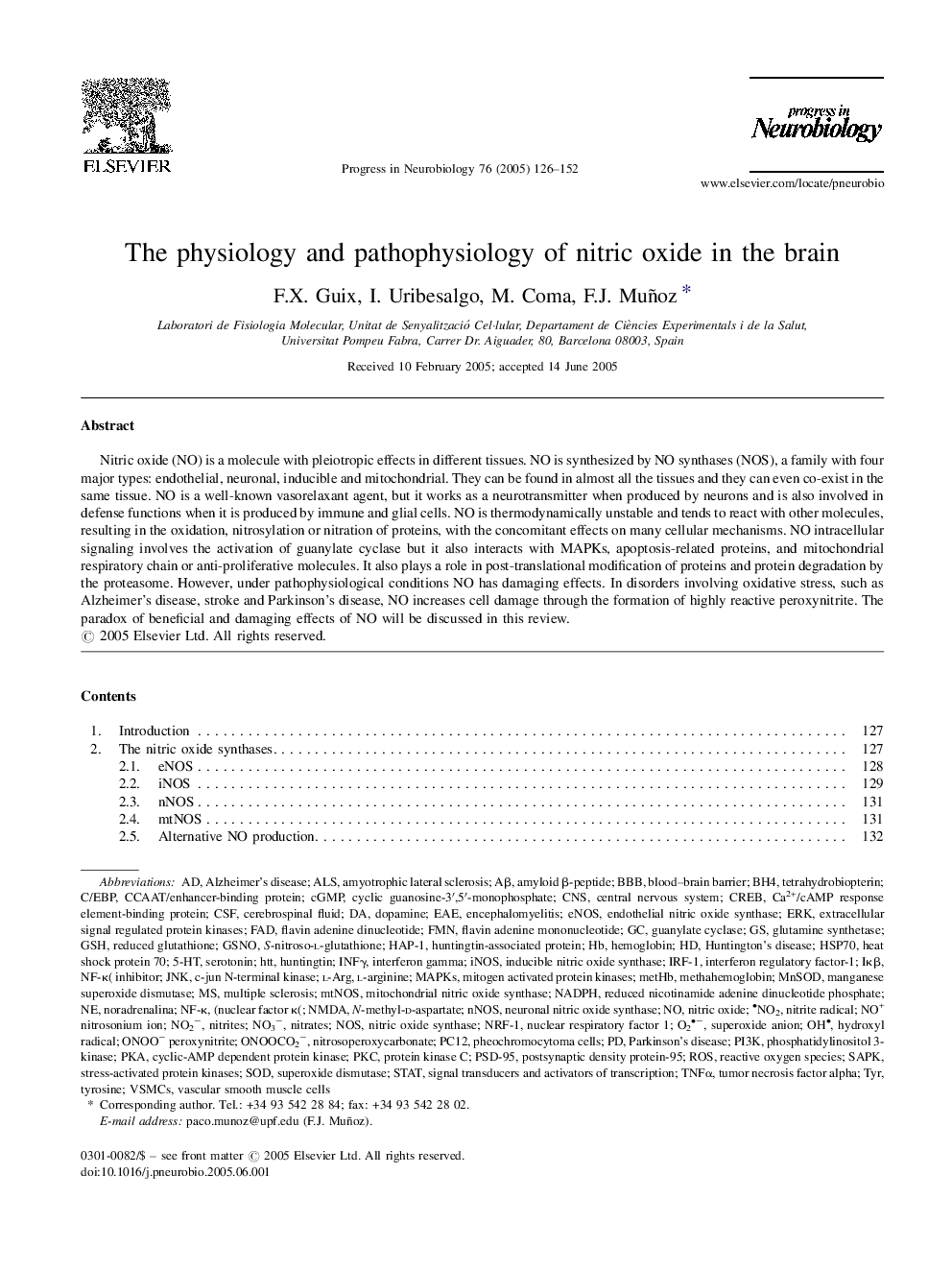| کد مقاله | کد نشریه | سال انتشار | مقاله انگلیسی | نسخه تمام متن |
|---|---|---|---|---|
| 9435156 | 1298561 | 2005 | 27 صفحه PDF | دانلود رایگان |
عنوان انگلیسی مقاله ISI
The physiology and pathophysiology of nitric oxide in the brain
دانلود مقاله + سفارش ترجمه
دانلود مقاله ISI انگلیسی
رایگان برای ایرانیان
کلمات کلیدی
CREBPI3K5-HTTNFαJnkflavin adenine dinucleotideFMNNADPHGSHAβcGMPERKNOSiNOShsp70eNOSpKaEAENMDAN-methyl-d-aspartatePSD-95nNOSMnSODPKCINFγNRF-1GSNOBH4tetrahydrobiopterinhttPC12NF-κVSMCsguanylate cyclaseIRF-1SAPKextracellular signal regulated protein kinasesmtNOSC/EBP - C / EBPc-Jun N-terminal kinase - C-Jun N-terminal kinaseMAPKs - MAPK هاMitogen activated protein kinases - Mitogen فعال پروتئین کینازNO2− - NO2-NO3− - NO3-O2− - O2-ROS - ROSamyloid β-peptide - β-پپتید آمیلوئیدl-arginine - آرژینین الSTAT - آمارencephalomyelitis - آنسفالومیلیتsuperoxide anion - آنیون سوپر اکسیدamyotrophic lateral sclerosis - اسکلروز جانبی آمیوتروفیکl-Arg - ال-آرژینینFAD - بدAlzheimer's disease - بیماری آلزایمرALS - بیماری اسکلروز جانبی آمیوتروفیکHuntington's disease - بیماری هانتینگتونParkinson's disease - بیماری پارکینسونtumor necrosis factor alpha - تومور نکروز عامل آلفاTyr - تیرTyrosine - تیروزینCNS - دستگاه عصبی مرکزیDopamine - دوپامینHydroxyl radical - رادیکال هیدروکسیلSOD - سدBBB - سد خونی مغزیBlood–brain barrier - سد خونی مغزیSerotonin - سروتونینVascular smooth muscle cells - سلول های عضلانی صاف عروقیpheochromocytoma cells - سلولهای فئوکروموسیتوماinducible nitric oxide synthase - سنتاز اکسید نیتریک القاییendothelial nitric oxide synthase - سنتاز اکسید نیتریک اندوتلیالneuronal nitric oxide synthase - سنتاز اکسید نیتریک عصبیmanganese superoxide dismutase - سوپر اکسید دیسموتاز منگنزSuperoxide dismutase - سوکسوکس دیسموتازMitochondrial nitric oxide synthase - سیتواستات اکسید نیتریکونcentral nervous system - سیستم عصبی مرکزیNuclear respiratory factor 1 - عامل تنفسی هسته ای 1interferon regulatory factor-1 - فاکتور تنظیمی اینترفرون 1Phosphatidylinositol 3-kinase - فسفاتیدیلینواستیل 3-کینازCerebrospinal fluid - مایع مغزی نخاعیCSF - مایع مغزی نخاعیsignal transducers and activators of transcription - مبدل سیگنال و فعال کننده رونویسیmetHb - مت هابMultiple sclerosis - مولتیپل اسکلروزیس(ام اس)Noradrenalina - نورآدرنالینNitrates - نیترات هاnitrosoperoxycarbonate - نیتروسوروکس کربناتNO2 - نیتروژن دیاکسیدNitrites - نیتریتNitric oxide - نیتریک اکسیدnitric oxide synthase - نیتریک اکسید سنتازHuntingtin - هانتینگتنHemoglobin - هموگلوبینCCAAT/enhancer-binding protein - پروتئین CCAAT / تقویت کنندهheat shock protein 70 - پروتئین شوک حرارت 70postsynaptic density protein-95 - پروتئین چگالی پستانیپتیک 95Protein kinase C - پروتئین کیناز سیreduced nicotinamide adenine dinucleotide phosphate - کاهش نیکوتین آمید آدنین دینکلوتید فسفاتreduced glutathione - کاهش گلوتاتیونstress-activated protein kinases - کیناز پروتئین فعال استرسInterferon gamma - گاما اینترفرونGlutamine synthetase - گلوتامین سنتتازcyclic guanosine-3′,5′-monophosphate - گنوزین سیکل 3 '، 5'-مونوفسفرهReactive oxygen species - گونههای فعال اکسیژن
موضوعات مرتبط
علوم زیستی و بیوفناوری
علم عصب شناسی
علوم اعصاب (عمومی)
پیش نمایش صفحه اول مقاله

چکیده انگلیسی
Nitric oxide (NO) is a molecule with pleiotropic effects in different tissues. NO is synthesized by NO synthases (NOS), a family with four major types: endothelial, neuronal, inducible and mitochondrial. They can be found in almost all the tissues and they can even co-exist in the same tissue. NO is a well-known vasorelaxant agent, but it works as a neurotransmitter when produced by neurons and is also involved in defense functions when it is produced by immune and glial cells. NO is thermodynamically unstable and tends to react with other molecules, resulting in the oxidation, nitrosylation or nitration of proteins, with the concomitant effects on many cellular mechanisms. NO intracellular signaling involves the activation of guanylate cyclase but it also interacts with MAPKs, apoptosis-related proteins, and mitochondrial respiratory chain or anti-proliferative molecules. It also plays a role in post-translational modification of proteins and protein degradation by the proteasome. However, under pathophysiological conditions NO has damaging effects. In disorders involving oxidative stress, such as Alzheimer's disease, stroke and Parkinson's disease, NO increases cell damage through the formation of highly reactive peroxynitrite. The paradox of beneficial and damaging effects of NO will be discussed in this review.
ناشر
Database: Elsevier - ScienceDirect (ساینس دایرکت)
Journal: Progress in Neurobiology - Volume 76, Issue 2, June 2005, Pages 126-152
Journal: Progress in Neurobiology - Volume 76, Issue 2, June 2005, Pages 126-152
نویسندگان
F.X. Guix, I. Uribesalgo, M. Coma, F.J. Muñoz,